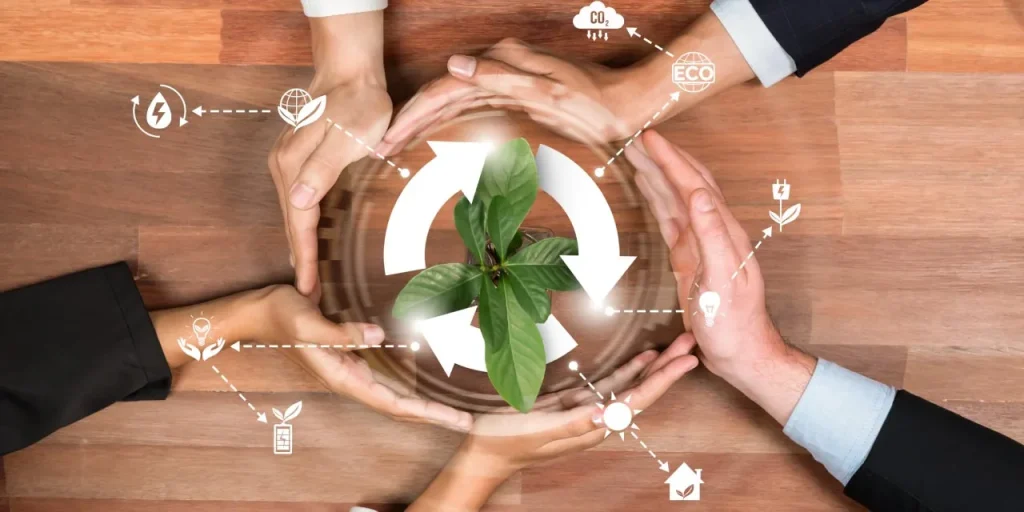
The integration of circular economy principles into the renewable energy sector signifies a transformative shift towards sustainability and efficiency. This change is crucial as the global energy landscape transitions from fossil fuels to renewable sources such as solar, wind, and geothermal power. The circular economy model in renewable energy focuses on extending the lifecycle of materials, advocating for their reuse, refurbishment, and recycling. These practices contribute to a more sustainable and efficient system, which is essential in the realm of renewable energy, where the circular economy represents a paradigm shift.
The Need for a Circular Economy in Renewable Energy
In the evolving landscape of renewable energy, the transition from the traditional linear ‘take-make-dispose’ model to a circular economy is not only environmentally critical but also economically advantageous. Traditional models, characterized by excessive resource use and waste, are being reevaluated in favor of extending the lifecycle of materials used in renewable energy technologies. This shift towards a circular economy focuses on innovative design solutions that facilitate easy repair, refurbishment, and recycling of equipment. By adopting these strategies, reliance on new raw materials decreases and waste generation is minimized. Inkel Limited, renewable energy experts in Kerala, recognizes the importance of this transition and is actively engaged in developing and implementing innovative solutions that align with the principles of the circular economy, enhancing the sustainability of renewable energy technologies.
A Sustainable Transition
The adoption of a circular economy model in the renewable energy sector marks a significant stride towards sustainability, offering a dual advantage of reducing emissions and conserving natural resources. This shift from traditional linear models, characterized by high resource consumption and waste, focuses on maximizing the longevity and utility of materials used in renewable energy technologies. By implementing practices such as the recycling and repurposing of materials from decommissioned equipment, the renewable energy sector can drastically decrease its reliance on new raw materials, thereby reducing the environmental impact associated with their extraction and processing. This approach not only conserves valuable resources but also minimizes the greenhouse gas emissions linked to raw material production, leading to a cleaner and more sustainable energy future.
In addition to lowering emissions, the circular model enhances resource efficiency within the renewable energy sector. Strategies like extending the lifespan of equipment through innovative design, refurbishing and repairing existing components, and recirculating materials back into the production cycle are pivotal. These methods effectively reduce the need for primary industrial materials, thereby lessening the ecological footprint of renewable energy technologies. The environmental benefits extend beyond resource conservation, mitigating habitat destruction, water use, and pollution typically associated with raw material extraction. Consequently, this transition to a circular economy within the renewable energy sector aligns with global goals of environmental preservation and sustainable development, paving the way for a more ecologically responsible and economically viable energy landscape.
Economic and Social Benefits
Integrating circular economy practices in the renewable energy sector is a multifaceted strategy that goes beyond environmental conservation to stimulate economic growth and social development. This approach, which includes recycling and refurbishing activities, particularly in the context of renewable energy equipment like solar panels, opens up new industrial avenues and fosters job creation across various skill levels and sectors. These practices not only lead to the emergence of new businesses focused on recovery, refurbishment, and material reprocessing, but also drive innovation in product design and recycling technologies. This shift towards sustainable resource management also engages communities, enhances awareness of renewable energy, and contributes to social equity by creating jobs in diverse regions. Moreover, this model bolsters long-term economic resilience by reducing dependency on raw materials and mitigating the impact of global market fluctuations, thereby shaping a sustainable, equitable, and prosperous economic landscape.
Addressing the Challenge of Obsolete Equipment
As the deployment of renewable energy technologies like solar panels and wind turbines expands, a significant challenge emerges in managing decommissioned equipment. The circular economy model offers a comprehensive solution to this issue by advocating for the systematic recovery, reuse, and remanufacturing of parts and materials. This approach significantly mitigates the need to dispose of obsolete equipment in landfills, thus reducing environmental pollution. It involves innovative practices in recycling technologies, extending the lifecycle of materials and parts through refurbishing and remanufacturing. These efforts are further supported by effective policy frameworks and industry standards, which encourage recycling and refurbishment. By implementing these strategies, the renewable energy sector can effectively address the challenge of obsolete equipment, contributing to environmental sustainability and resource conservation.
Policy and Regulatory Framework
A comprehensive policy and regulatory framework is crucial for the successful implementation of a circular economy in the renewable energy sector. Such a framework should encompass regulations that clearly define recycling responsibilities among manufacturers, consumers, and recyclers, ensuring a shared commitment to the end-of-life management of renewable energy products. It should also establish standards and certification processes to guarantee the quality and safety of recycled materials and products. Effective data collection and reporting systems are essential for tracking the lifecycle of renewable energy equipment, providing insights for continuous improvement. Financial and fiscal policies, including incentives and penalties, are key to encouraging adherence to circular economy practices. Finally, public awareness initiatives are vital in educating consumers about the benefits of sustainable products and the importance of recycling, thereby driving demand for products designed for circularity. Altogether, this multi-dimensional framework is essential for driving environmental sustainability and fostering economic growth in the renewable energy sector.
Inkel Limited: Pioneering Sustainable Energy Solutions in Kerala
Inkel Limited, renewable energy experts in Kerala, is at the forefront of integrating circular economy principles into our renewable energy endeavors. Our dedication to sustainability is evident in our approach to not only generating clean energy but also in the responsible management of resources throughout their entire lifecycle. This commitment positions us as leaders in driving sustainability, reducing environmental impacts, and encouraging economic growth. Our focus on the circular economy within the renewable energy sector exemplifies our innovative strategy and accentuates our role in paving the way towards a sustainable future.

+91 484-2978101 (09:30 AM – 5:30 PM)
Designed by